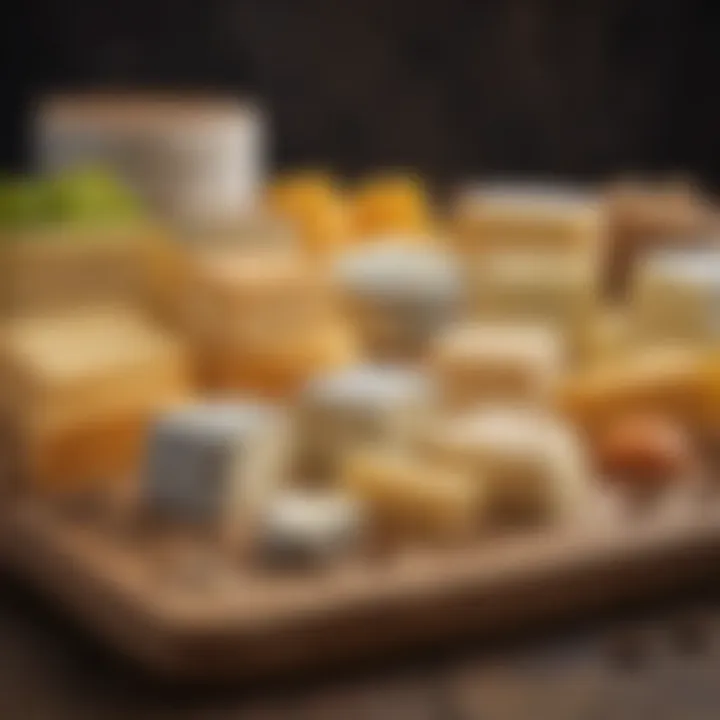Exploring Cheese Alternatives: Non-Dairy Delights


Intro
The exploration of non-milk cheese alternatives has gained momentum in recent years. This shift arises from growing awareness of health and environmental issues associated with dairy consumption. Cheese alternatives cater to various dietary preferences, whether for ethical, health, or allergy reasons. This article examines the various forms of non-dairy cheeses, their nutritional aspects, production methods, and the rich cultural significance they hold.
In recent times, many individuals are embracing plant-based diets. The reasons for this shift are diverse, often influenced by health considerations, environmental concerns, or ethical factors. Notably, the market for non-dairy cheeses has become increasingly competitive. Understanding this field is essential for those looking to maintain a balanced diet without sacrificing flavor or texture.
The term "non-milk cheese" refers to a wide range of products made from alternatives to traditional dairy milk. These can include nut-based cheeses, soy-based options, and even those made from coconut or grains. Each of these varieties brings unique flavors and textural properties, allowing for a versatile incorporation in various dishes.
As we dive deeper into this article, we will explore the various aspects of cheese alternatives. Topics include nutritional profiles, production methods, and culinary applications as well as cultural implications. This exploration is vital for anyone interested in understanding the contemporary landscape of food culture and health.
Preamble to Non-Milk Cheese
The rise of non-milk cheese alternatives marks a significant shift in how we approach food, especially for those following plant-based diets. With growing awareness of lactose intolerance, dietary restrictions, and ethical concerns surrounding animal products, non-milk cheese provides an option for a broader audience. This section serves to lay the groundwork for understanding these alternatives, exploring their relevance in modern culinary practices and the implications they carry. Non-milk cheese can enrich meals without compromising dietary choices, which is an important consideration for food enthusiasts and professionals alike.
Definition and Overview
Non-milk cheese refers to cheese alternatives made without any dairy or animal-derived ingredients. These products range widely in terms of base ingredients, which may include nuts, soy, and other plant sources. The variety allows for different textures and flavors that somewhat mimic traditional cheese but with distinct profiles.
In recent years, the demand for non-milk cheese has been driven by several factors:
- Dietary Changes: Many people are transitioning to plant-based diets for health benefits or ethical reasons.
- Innovative Products: Advances in food technology have led to more palatable and versatile non-dairy options.
- Environmental Concerns: Consumers are more aware of the environmental impact of dairy production and seek sustainable alternatives.
The potential benefits of non-milk cheese extend beyond health and into ethical and environmental dimensions. As more individuals seek products that align with their values, understanding non-milk cheese becomes essential for discerning consumers.
The aim is not just to replicate traditional cheese but to expand the culinary landscape. Non-milk cheese invites creativity and innovation in cooking, catering to a diverse range of dietary preferences while remaining accessible to everyone. In this exploration, the significance of these alternatives will be unpacked, leading to an appreciation for their role in contemporary cuisine.
Historical Context of Cheese Production
The history of cheese is a reflection of human ingenuity and resourcefulness. It stretches back thousands of years, demonstrating humanity’s ability to adapt to changing circumstances. Understanding this historical context helps one appreciate the journey from traditional dairy cheese to the emergence of non-milk alternatives.
From ancient civilizations, cheese has long served as a means of preserving milk in a more digestible form. Early dairy farmers discovered that curdling milk through fermentation resulted in a variety of textures and flavors. Traditionally, cheese production techniques were passed down through generations, often linked to regional practices.
As dietary preferences shifted, so too did the market for cheese. The increase in lactose intolerance diagnoses and a growing awareness of animal welfare pushed many to explore cheese alternatives. Thus, the landscape of cheese began to change. Non-milk cheese emerged as a significant product, rooted in the principles of sustainability and health consciousness.
In contemporary society, the distinction between traditional cheese and non-milk cheese becomes a focal point of conversation. Traditional cheese often relies heavily on cow, goat, or sheep's milk as its primary ingredient. This dairy-centric approach raises questions about dietary inclusivity and environmental sustainability. Conversely, non-milk cheese includes various alternative bases such as nuts, soy, and coconut, catering to those who avoid dairy for health or ethical reasons.
Traditional Cheese vs. Non-Milk Cheese
Traditional cheese production represents the age-old practices that prioritize animal-derived ingredients. While these cheeses vary widely in flavor and texture, they typically offer a rich source of calcium and protein. However, the reliance on animal sources brings with it concerns regarding lactose intolerance and the environmental impact of dairy farms.
In contrast, non-milk cheese innovates on these traditional foundations, often using plant-based ingredients. This shift challenges conventional ideas of what cheese can be while providing essential nutrients from alternative sources.
Key Differences:
- Ingredients: Traditional cheese primarily uses milk from animals, whereas non-milk cheese employs nuts, soy, or other plant-based materials.
- Nutritional Content: Non-milk options can often be lower in saturated fats and cholesterol, appealing to health-conscious consumers.
- Production Methods: Non-milk cheese utilizes fermentation techniques similar to traditional cheese but applies them to new bases, producing unique flavors and textures.
The transition from traditional to non-milk cheese illustrates a broader dietary shift towards sustainability and health, reflecting changing consumer values.
This historical context illuminates the evolution of cheese and sets the stage for deeper explorations into the diverse offerings of non-milk cheese. Through this lens, one can appreciate both the roots of cheese-making and its future possibilities.
Types of Non-Milk Cheese
The topic of non-milk cheese is significant as it highlights the variety and adaptability of cheese alternatives in a world that increasingly values health, ethics, and environmental awareness. The demand for non-dairy options has surged, driven by various factors such as lactose intolerance, vegan diets, and a general preference for plant-based lifestyles. Understanding the types of non-milk cheese available allows consumers to make informed choices that align with their dietary requirements while still enjoying the flavors and textures associated with traditional cheese.
Plant-Based Cheese
Plant-based cheese encompasses various categories, often made from nuts, soy, coconut, or other plant-derived ingredients. Each type provides specific benefits and considerations that enhance the overall offerings of non-milk cheese.
Nut-Based Cheese
Nut-based cheese is primarily made from nuts like cashews, almonds, or macadamias. One key characteristic of nut-based cheese is its rich and creamy texture, which closely resembles traditional cheese. This feature makes it a popular choice among those seeking alternatives that do not sacrifice mouthfeel. The nutritional profile is often favorable, providing healthy fats and proteins. However, one disadvantage is potential allergies related to nuts, which limits its accessibility.
Soy-Based Cheese
Soy-based cheese is typically produced from soy milk and is well-known for its high protein content. This type of cheese is a beneficial choice because it can be low in saturated fats, which appeals to health-conscious consumers. A unique feature of soy-based cheese is its versatility in various dishes, from pizzas to sandwiches. On the downside, some consumers may be hesitant due to concerns about soy allergies or the presence of genetically modified organisms.
Coconut-Based Cheese
Coconut-based cheese offers a distinct flavor profile, often lending a slightly sweet taste. This type of cheese is especially valuable for its creaminess, which can enhance dishes such as pasta or curries. Its unique benefit lies in its exoti, making it appealing for culinary experimentation. However, it may symbolize a high saturated fat content, which some health-conscious individuals may want to limit.
Fermented Non-Dairy Cheese
Fermented non-dairy cheese represents an innovative approach to creating cheese alternatives that mimic the tangy flavors associated with aged cheeses. The fermentation process not only enhances flavors but also adds probiotic benefits, contributing positively to gut health.
Probiotic Benefits
The probiotic benefits of fermented non-dairy cheese are noteworthy. These live microorganisms can improve digestive health and boost immunity. This feature makes fermented non-dairy cheese a beneficial option for those looking to maintain a healthy gut flora. However, people with dairy allergies should exercise caution, as some brands may cross-contaminate.
Flavor Development


Flavor development in fermented non-dairy cheese can be quite complex, often involving various strains of bacteria that develop depth and richness over time. This characteristic contributes significantly to the overall appeal of these cheeses for culinary uses. A major advantage is the ability to create cheese that mimics the flavors of traditional dairy counterparts, but it can come with a longer production time, which may deter some consumers.
Processed Vegan Cheese
Processed vegan cheese illustrates a different approach, focusing on convenience and accessibility. Many consumers appreciate the instant gratification that comes from this type, often used in quick meals and snacks.
Ingredients and Additives
The ingredients and additives in processed vegan cheese are essential to its final product. Many varieties incorporate starches, oils, and flavor enhancers to achieve a desirable melt and taste. This characteristic appeals to busy individuals or families seeking easy meal solutions. However, it often raises concerns about the nutritional quality compared to whole-food alternatives.
Texture and Flavor Profile
The texture and flavor profile of processed vegan cheese can be engineered to mimic various traditional cheese types. This unique feature makes it suitable for a broad range of applications, from sandwiches to sauces. Nevertheless, the trade-off may be a less satisfying taste or texture when compared to less processed options, leading some consumers to seek out better-quality substitutes.
Nutritional Analysis of Non-Dairy Cheeses
The growing interest in non-dairy cheese has prompted a need for a clear nutritional analysis of these products. Understanding their nutritional profiles allows consumers to make informed choices, particularly for those adjusting their diets for health, ethical, or environmental reasons. Non-dairy cheeses, while influenced by ingredients, can offer a variety of nutrients, making them important in the context of overall dietary considerations.
Comparative Nutritional Value
Protein Content
Protein is a key aspect of nutrition. Non-dairy cheeses often contain varying levels of protein depending on their ingredient composition. For example, nut-based cheeses, such as those made from cashews or almonds, generally have a higher protein content compared to others. This attribute makes them a popular choice for individuals seeking to maintain or increase protein intake without consuming animal products. However, one must consider that the protein in non-dairy cheeses can be lower in certain essential amino acids compared to dairy products.
Key characteristic of protein in non-dairy cheeses is its source. Some non-dairy varieties might not provide a complete protein profile unless combined with other sources. This is an important factor for those who depend heavily on these products for their protein needs.
Fats and Carbohydrates
The fats and carbohydrates present in non-dairy cheeses are also worth examining. Many non-dairy options have fats derived from nuts or coconut oil. These fats can provide healthy energy but can also lead to an increased caloric intake. Therefore, while they may favorably affect heart health, moderation is essential for those tracking caloric consumption.
Furthermore, the carbohydrate content can vary significantly. Some processed vegan cheeses may contain higher amounts of carbohydrates, particularly if thickening agents or sweeteners are added. This aspect is critical to consider for individuals who are monitoring their carbohydrate intake for health reasons, such as diabetes.
Micronutrients
Micronutrients in non-dairy cheese play an important role in overall health. A variety of vitamins and minerals can be present, depending on the ingredients used. For instance, non-dairy cheeses made with nutritional yeast can be fortified with B vitamins, particularly B12, which is essential for those following vegan diets.
However, it is essential to evaluate the unique feature of non-dairy cheeses regarding their micronutrient content. Some may lack important vitamins and minerals found in traditional cheese, such as calcium and vitamin D. Therefore, it is advisable for consumers to explore which varieties might be fortified or naturally rich in these nutrients.
"Understanding the nutritional aspects of non-dairy cheeses can empower consumers to integrate them properly into their meals, maximizing both health benefits and enjoyment."
In summary, while non-dairy cheese products can offer a variety of nutritional benefits, consumers should consider their specific dietary needs. This includes evaluating protein sources, fat and carbohydrate levels, and micronutrient profiles. Understanding these factors can help consumers make choices that align with their health goals.
Production Methods
Understanding production methods is crucial in the realm of non-dairy cheese. These methods determine not only the taste and texture of the final product but also its nutritional profile and cultural significance. As more consumers seek plant-based alternatives, comprehending how these cheeses are made becomes fundamental. The production methods encompass various ingredients, fermentation practices, and manufacturing processes, all contributing to the diverse world of non-milk cheese.
Ingredients and Fermentation
Ingredients play a vital role in crafting non-dairy cheese. Common bases include nuts, soy products, coconuts, and sometimes starches or plant oils. Each ingredient imparts different flavors and textures, catering to various culinary needs.
Fermentation is another key process that contributes to developing flavor profiles. By introducing specific cultures, producers can create tangy, complex cheeses. For example, fermented cashew cheese utilizes the natural enzymes from cashews, yielding a creamy, rich texture comparable to traditional dairy cheese. This process can also enhance the nutritional value by increasing probiotic content, making it beneficial for gut health.
Manufacturing Processes
Blending and Molding
Blending and molding are essential steps in the production of non-dairy cheese. During blending, ingredients are mixed to achieve a consistent texture. This step is crucial as it ensures all components are well incorporated before the cheese sets. Molding follows blending, where the mixture is shaped into its final form. This process allows for creativity in presentation and serving. An advantage of this method is the versatility it offers. Different molds can create diverse shapes and sizes, appealing to consumers.
However, there can be drawbacks. Improper blending might lead to separation, affecting the cheese's overall quality. Hence, the importance of precision in this step cannot be understated.
Aging Techniques
Aging techniques significantly influence the flavor and texture of non-dairy cheese. Aging is the process where cheese is stored under controlled conditions for a certain period. This allows complex flavors to develop and can create a firmer texture. The environmental conditions, such as humidity and temperature, are carefully monitored. This method is increasingly popular among artisans aiming to replicate the nuanced tastes found in traditional cheeses.
Furthermore, the unique feature of aging is its ability to reduce the water content, which concentrates flavors. This process can also bring about health benefits by developing beneficial microbes. On the downside, not all non-dairy cheeses benefit from aging, as some may lose their desired texture or flavor, necessitating a careful approach.
Overall, the production methods employed in non-dairy cheese highlight the intersection of science and culinary art. Understanding these processes provides insights into the industry's growth and the potential advantages non-dairy options offer.
Culinary Uses of Non-Dairy Cheese
The culinary applications of non-dairy cheese are both vast and varied. As more consumers pivot towards plant-based options, the importance of understanding how to use these alternatives becomes crucial. Non-dairy cheese can be a versatile element in many dishes, offering flavor and texture without relying on traditional dairy. Each type of non-dairy cheese has its unique characteristics, which can influence its use and pairing in cooking.
In Cooking and Baking
Substituting Dairy Cheeses
Substituting dairy cheeses with non-dairy varieties allows for creativity in recipes. This transition caters to those with dietary restrictions or ethical concerns regarding animal products. One key characteristic of non-dairy cheeses is that they often replicate the taste and texture of their dairy counterparts. For example, cashew-based cream cheeses can provide a similar creaminess to ricotta.
However, non-dairy cheese may have variances in melting qualities. This can affect certain dishes, such as pizza or lasagna, which rely on gooey, melted cheese. Thus, careful selection is needed when substituting to achieve the desired consistency and flavor.
Pairing with Other Ingredients


Pairing non-dairy cheese with other ingredients can enhance the overall flavor profile of a meal. The key characteristic of plant-based cheeses is their ability to complement various herbs, spices, and vegetables. For example, a sharp vegan cheddar can add depth to a stir-fry, while a creamy almond cheese can elevate a fresh salad.
Choosing the right pairs is essential for balancing flavors. In dishes like pasta or casseroles, the combination with robust sauces and savory spices can make these plant-based alternatives shine. However, it is vital to consider potential flavor clashes; thus, experimentation is encouraged in the kitchen to find the perfect match.
As a Stand-Alone Ingredient
Serving Options
Non-dairy cheese can serve as a stand-alone ingredient in many dishes. The characteristic versatility of these cheeses allows them to be enjoyed on their own. They can be sliced, cubed, or spread to create delicious cheese platters. For instance, a selection of nut-based cheese can provide a gourmet touch to any appetizer arrangement.
However, the distinct flavor profiles of non-dairy cheese sometimes require thoughtful pairing with fruits, crackers, or breads. This can elevate the tasting experience and provides an opportunity to highlight the unique tastes of the cheese.
Presentation Techniques
Presentation techniques for non-dairy cheese can significantly enhance its appeal. A well-arranged cheese board can be an art form, featuring various textures and colors from different non-dairy cheeses. The key characteristic here is how visual presentation can heighten the experience of consuming plant-based cheese.
Creative plating can also involve drizzling with oils or garnishing with fresh herbs, giving added visual and aromatic appeal. However, finding balance in presentation can sometimes be challenging, especially with alternative ingredients that might not have the same visual impacts as traditional cheeses.
Overall, the culinary uses of non-dairy cheese highlight its growing relevance in the kitchen. It serves multiple roles—whether as a direct substitute, an ingredient in cooking, or as part of an appetizing display. Each type offers distinct advantages and requires consideration of its unique features to maximize enjoyment.
Market Dynamics of Non-Dairy Cheese
The market dynamics surrounding non-dairy cheese are pivotal in understanding the growing industry of cheese alternatives. This segment reflects the interplay of consumer preferences, production developments, and sustainability concerns. It outlines how these factors are not just trends, but fundamental shifts in how society views food. The rising demand for non-dairy cheese is not an isolated phenomenon; it is indicative of broader changes in dietary habits and environmental awareness.
Consumer Trends
Consumer trends reveal the motivations behind the increasing popularity of non-dairy cheese. Factors influencing these trends include personal health, ethical considerations, and environmental impact. The growing awareness of lactose intolerance, coupled with health consciousness, has led many to explore alternatives like those derived from nuts, soy, and other plant sources.
Growth of Plant-Based Diets
The growth of plant-based diets is a significant driver for the demand of non-dairy cheese. This dietary shift highlights a broader shift towards health, wellness, and environmental sustainability. Consumers adopt plant-based diets not just for ethical or health reasons but also due to the desire to include more natural ingredients in their meals. This movement has led to increasing experimentation and innovation within the non-dairy cheese sector.
Key characteristic: Health benefits such as lower cholesterol levels and a reduction in saturated fats make plant-based diets attractive.
Unique feature: Many plant-based cheeses are inherently rich in fibers and vitamins that contribute to overall well-being.
However, some may find the texture and flavor profiles of these products challenging in comparison to traditional cheeses. These factors can create a barrier for some consumers who may be hesitant to fully embrace non-dairy options.
Target Demographics
Identifying target demographics is essential for brands looking to market non-dairy cheese. This demographic includes vegetarians, vegans, individuals with lactose intolerance, and health-conscious consumers. Engaging with these groups effectively can enhance brand loyalty and product adoption.
Key characteristic: Demographics vary widely from young adults to older populations, reflecting diverse motivations across age groups.
Unique feature: Younger consumers tend to prioritize ethical considerations as a primary reason for choosing non-dairy products. As such, they often seek transparency in production and sourcing of ingredients.
This canbe seen as both an advantage and disadvantage; while it encourages brands to innovate, it also means they must uphold high ethical standards to retain this consumer base.
"The shift towards non-dairy cheese is more than a dietary trend; it reflects a growing movement towards more sustainable and ethical food choices in our society."
End
In summary, understanding the market dynamics surrounding non-dairy cheese involves examining consumer trends and target demographics. As the adoption of plant-based diets continues to rise, it influences not only the products that are available but also how these products are positioned in the market. Engaging with these trends can provide insights for producers and retailers looking to capitalize on the growing demand for non-dairy alternatives.
Health Considerations
Understanding health considerations is vital when discussing non-milk cheese alternatives. As more individuals move towards plant-based eating, knowing the impacts on health, such as allergies, intolerances, and nutrient profiles, becomes essential. Non-milk cheeses can provide options for people with dietary restrictions while also presenting possible health benefits. However, they come with considerations that should not be overlooked.
Allergies and Intolerances
Lactose Intolerance
Lactose intolerance is a common digestive issue that affects many people globally. It occurs when the body cannot properly digest lactose, a sugar found in milk. For these individuals, consuming dairy products often leads to discomfort, making lactose-free options attractive. Non-milk cheeses, which do not contain lactose, serve as a beneficial alternative. They offer flavors similar to traditional cheese without the risk of indigestion.
Unique to lactose intolerance is the ability to enjoy a dairy-like experience without side effects. This appeal is particularly relevant when considering those who enjoy cheese in their diets but cannot consume dairy. Non-milk cheeses created from nuts, soy, and other plant-based sources deliver a creamy texture and taste, highlighting their importance in this article.
Some typical nut-based cheeses might be suitable for lactose-intolerant consumers. For example, cashew cheese blends smoothly, often being both creamy and delicious. However, consumers should always check labels to ensure the absence of dairy, as cross-contamination can occur during production.
Nut Allergies
Nut allergies represent a significant health concern for many individuals, often resulting in severe reactions. This issue can complicate the consumption of non-milk cheese since many variations rely on nuts as base ingredients, like cashews and almonds. Therefore, it becomes crucial for producers to offer nut-free cheese alternatives for allergic consumers.
In this article, highlighting the ramifications of nut allergies is essential. Understanding that some may not have access to delicious non-dairy cheeses leads us to suggest alternatives based on soy or coconut. These options hold significance as producers increasingly create diverse cheese alternatives that cater to various dietary restrictions.
Identifying and labeling cheese alternatives correctly is vital so those with nut allergies have transparent choices. When diverted with nut-free products, consumers can still explore the pleasures of non-milk cheeses without health risks.
Possible Benefits and Drawbacks
Cholesterol Levels


One major benefit of non-milk cheese alternatives is their generally lower cholesterol content compared to traditional dairy options. Most plant-based cheeses contain no cholesterol, presenting a heart-healthy alternative in comparison. For those concerned about heart disease or managing weight, replacing dairy cheese with non-milk options can be advantageous.
This health aspect is particularly appealing for those looking to reduce dietary cholesterol. Individuals who follow plant-based lifestyles often experience lower LDL levels, which can result in long-term health benefits. However, it is crucial to be aware that some processed vegan cheeses can contain oils or additives that may introduce unhealthy fats.
Vitamin Deficiencies
Another consideration surrounding non-milk cheese is the potential for vitamin deficiencies. While non-dairy cheeses can offer variations in nutrient profiles, they often lack some vitamins typically found in dairy cheese, such as vitamin B12 and calcium. These gaps can be of concern for individuals relying significantly on such alternatives as their primary cheese sources.
Balancing the diet is key. It remains essential for consumers to monitor nutrient intake to ensure they meet their daily requirements. Combining non-milk cheeses with other nutrient-rich foods, such as leafy greens or fortified products, can enhance overall health without sacrificing taste.
Cultural Significance of Non-Milk Cheese
The emergence of non-milk cheese alternatives represents not just a dietary shift, but a broader cultural evolution within food consumption. As societies worldwide become more attuned to health, ethics, and environmental sustainability, the significance of these cheese alternatives transcends mere taste. Non-milk cheese embodies a growing awareness of dietary restrictions, animal welfare, and ecological consequences of food production methods. This section will illuminate the multifaceted cultural importance of non-milk cheese, focusing specifically on the regional variations that contribute to its appeal.
Regional Variations
Asian Alternatives
Asian alternatives to traditional cheese highlight unique methods and ingredients that are deeply rooted in their respective cultures. For instance, products like tofu and fermented soy products provide substitutes that resonate with the culinary practices of Asia. The characteristic feature of these alternatives is their versatility and how they can be adapted in numerous dishes—from stir-fries to desserts.
The use of ingredients like miso and nutritional yeast in Asian non-milk cheeses adds a rich umami flavor, enhancing overall dining experiences. Such flavors are often sought after by consumers aiming to replicate the savory taste profile of dairy cheese. The lower fat content in these alternatives makes them popular among those pursuing healthier options.
However, without proper knowledge, the preparation of these alternatives can pose challenges. Some may find the flavor profiles different from expected dairy counterparts, which could affect acceptance among those new to these options. Thus, Asian alternatives enrich the non-milk cheese narrative with distinctive flavors and textures that enhance culinary exploration.
European Innovations
On the other hand, European innovations within the non-dairy cheese space introduce traditional tastes while employing modern technology. For example, cashew-based cheeses are crafted to mimic textures and flavors of famous dairy cheeses like Brie or Gouda. The innovative aspect lies in the art of fermentation, where cultures and enzymes are blended to develop complex taste profiles. This method also allows for the production of cheeses that can be aged, akin to their dairy counterparts, showcasing a more sophisticated approach to non-dairy cheese.
Such innovations are crucial not only for flavor but also for the appeal among consumers who desire rich, satisfying experiences similar to traditional cheese. The success of brands like Violife and Daiya demonstrates this trend. Their products have successfully entered markets traditionally dominated by dairy, indicating high consumer acceptance and demand.
Yet, market saturation can also lead to challenges. Consumers may find it overwhelming to choose from a plethora of options, or struggle with the high prices typically associated with artisanal non-milk cheeses. Still, European advancements play a vital role in making non-milk cheese culturally significant. They reflect a melding of traditional food values with modern dietary preferences, ensuring that non-dairy cheese resonates across diverse food cultures.
In summary, the regional variations in non-milk cheese illuminate how culture influences food production and consumption. The diverse offerings from Asia and Europe provide unique flavors and textures that adapt to different culinary landscapes. As such, these cheese alternatives not only expand dietary choices but also foster cultural connections through shared meals, traditions, and innovation.
Environmental Impact of Cheese Production
The discussion around cheese alternatives extends beyond culinary preferences and nutritional benefits; it encompasses significant environmental considerations. Traditional cheese production has a notable ecological footprint. The dairy industry contributes to greenhouse gas emissions, requires extensive water resources, and impacts land use. By exploring non-dairy cheese options, we can assess how these alternatives might reduce environmental consequences while meeting the needs of a growing population.
Cheese production in the dairy sector predominantly relies on cattle farming. This method is land and resource-intensive, leading to deforestation and habitat degradation. Moreover, methane emissions from cows are significantly higher than from plant-based sources. According to various studies, dairy farming is responsible for approximately 2% of global greenhouse gas emissions. This stark statistic underscores the need for alternatives that minimize environmental harm.
In contrast, many non-dairy cheeses utilize plant-based ingredients. Ingredients like nuts, seeds, soy, and coconut can often be produced with a lower carbon footprint. By fostering plant-based production, we can encourage sustainable agricultural practices that promote biodiversity.
Sustainability of Non-Dairy Ingredients
Sustainability is a core principle in the production of non-dairy cheeses. Here are several aspects to consider:
- Diverse Ingredients: Options such as cashews, almonds, or tofu not only provide variety but also require fewer natural resources than dairy.
- Water Usage: Producing plant-based cheese typically consumes less water compared to dairy cheese. For example, almond consumption can use about 1 gallon per almond, while dairy requires much more.
- Soil Health: Pulse crops often play a role in non-dairy cheese production, contributing to soil fertility. This nourishes the land without the same drawbacks as monoculture dairies.
- Carbon Sequestration: Many plant operations promote techniques like crop rotation, resulting in healthier ecosystems that absorb CO2.
Future Trends in Non-Milk Cheese
The evolution of non-milk cheese reflects broader societal shifts in diet, sustainability, and health consciousness. As the demand for plant-based foods increases, understanding the future trends of non-milk cheese becomes crucial. These trends not only indicate where the market is heading but also how they reflect consumer values. Observing these trends informs producers, consumers, and health professionals on the benefits and considerations of non-dairy options.
Technological Advances in Production
New technologies are revolutionizing how non-milk cheese is produced. From fermentation techniques to ingredient sourcing, advancements allow for the creation of more sophisticated flavors and textures.
- Fermentation Technology: Innovative fermentation methods, including precision fermentation, are being used to create richer flavors and improve texture. This process employs microorganisms to transform plant-based ingredients into cheese-like products that mimic traditional dairy nuances.
- Ingredient Development: The focus on high-quality ingredients has led to new formulations. For instance, products utilizing pea protein, almond milk, or cashew nuts are becoming more common. These new ingredients provide greater nutritional benefits and cater to a range of dietary preferences.
- Sustainability Improvements: Eco-friendly practices in production methods are rising. Companies are employing less energy-intensive processes and reducing waste. This advancement appeals to environmentally-conscious consumers.
These advancements are not merely technical; they have considerable implications for flavor development and market acceptance.
Projected Market Growth
The market for non-milk cheese alternatives is anticipated to experience significant growth over the coming years. Several factors contribute to this trend:
- Increasing Demand for Plant-Based Products: As more people adopt plant-based diets, the demand for alternatives to traditional dairy cheese is skyrocketing. This shift is partly driven by health concerns, environmental awareness, and ethical considerations.
- Diverse Consumer Base: The appeal of non-dairy cheese extends beyond vegans to those with lactose intolerance or milk allergies. The increasing variety ensures that these products serve a larger segment of the population.
- Innovative Marketing Strategies: Brands are leveraging social media and online platforms to reach targeted demographics. Engaging social campaigns raise awareness about the benefits of non-dairy cheeses.
- Investment in Research and Development: Major food companies are investing in research to enhance the quality and availability of non-milk cheese products. This leads to better taste and lower prices, further increasing accessibility to consumers.
The future of non-milk cheese is promising. Observers project a continued ascent in the market, propelled by consumer trends and technological innovation.
"As more consumers seek healthier and sustainable alternatives, the landscape of non-milk cheese will significantly evolve."
The End
The exploration of non-milk cheese is increasingly relevant in today's culinary landscape. This article has outlined various essential elements pertaining to this topic, highlighting the importance of understanding non-dairy alternatives. Non-milk cheese caters not only to dietary restrictions but also to a growing demand for sustainable and plant-based options.
There are several benefits associated with adopting non-milk cheese, which include:
- Diverse Nutritional Profiles: Many non-dairy cheeses offer unique health benefits. They can be lower in saturated fats and cholesterol when compared to traditional cheese, making them appealing for health-conscious consumers.
- Environmental Impact: The production of non-milk cheese has a smaller carbon footprint. Utilizing plant-based ingredients reduces reliance on animal farming, potentially lowering greenhouse gas emissions.
- Culinary Versatility: Non-milk cheeses are versatile across various cuisines. From creamy nut-based spreads to fermented soy varieties, they provide myriad options for culinary experimentation.
In the realm of non-milk cheese, considerations such as ingredient sourcing and health implications remain critical. Consumers should be aware of the types of additives used, as some processed options may not align with clean eating ideals. On the other hand, naturally fermented varieties often come with nutritional perks like probiotics.
Overall, the future of non-milk cheese looks promising. As innovation continues in production techniques and flavor profiles, it is likely that these alternatives will further secure their place in modern diets. This article presents a comprehensive guide to the world of non-milk cheese, reflecting fundamental insights into a burgeoning market that strives for sustainability, health, and culinary enjoyment.
Summary of Key Points
- Non-milk cheese serves as a valuable alternative for people with lactose intolerance or dietary restrictions.
- Plant-based options offer unique nutritional benefits and create opportunities for ingredient innovation.
- It's essential to choose non-dairy cheeses mindfully. Consumers should consider nutritional value and ingredient quality when making choices.
- The environmental impact of non-milk cheese production is generally more favorable compared to that of traditional dairy cheese.
As this market evolves, staying informed about developments in non-milk cheese will enhance the experiences of both consumers and culinary enthusiasts.







